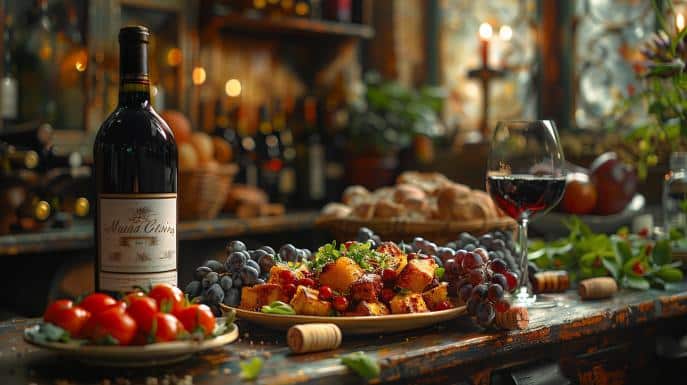Imagine aquela refeição inesquecível, onde cada garfada parece dançar em harmonia com o vinho escolhido, criando uma sinfonia de sabores no paladar. “Como Escolher o Par Perfeito” não é apenas o título do nosso guia; é a promessa de que, ao fim deste artigo, sua mesa será palco de encontros estelares entre vinhos e receitas. Com destreza, equilibramos dicas de harmonização com vinho e deciframos os segredos para casamentos perfeitos. Preparado para transformar suas refeições em obras-primas gastronômicas? Vamos desvendar juntos neste guia supremo de harmonização.
Como posso harmonizar vinhos e comidas efetivamente para realçar uma refeição?
Quando buscamos harmonizar vinhos e comidas, o princípio básico é equilibrar intensidade: sabores vigorosos pedem vinhos marcantes, enquanto pratos delicados se aliam a vinhos mais leves. Por exemplo, Carnes vermelhas ricas combinam com a estrutura tânica de um Cabernet Sauvignon; já o frescor de um Sauvignon Blanc realça peixes leves. Em eventos especiais, considere a temática e a sofisticação do menu – um Pinot Noir pode ser versátil, adequando-se a diversas preparações. A experiência culinária ascende quando a combinação estimula os sentidos, proporcionando um diálogo harmonioso entre prato e bebida. Explore esta arte da harmonização e sua refeição se transformará numa sinfonia de sabores.
Quais vinhos combinam melhor com carnes e queijos?
Os melhores vinhos para acompanhar carnes vermelhas tendem a ser tintos robustos, como o Cabernet Sauvignon, que conta com alta presença de taninos, fornecendo estrutura para contrabalancear a riqueza da carne. Para peixes e frutos do mar, o ideal geralmente é um vinho branco leve como o Chardonnay ou Sauvignon Blanc, que, com sua acidez, complementa sabores suaves do mar. Ao degustar queijos, a diversidade no perfil de sabor e textura dos queijos dita a escolha do vinho. Queijos fortes pedem vinhos com maior acidez ou mais corpo. Experimente um tinto encorpado com queijos duros ou um vinho doce, como o Sauternes, para contrastar com queijos azuis. Descubra a harmonização perfeita explorando mais detalhes sobre vinhos e queijos.
É possível encontrar um vinho que combine com pratos vegetarianos e temperos específicos?
Sugestões de vinhos para pratos vegetarianos variam conforme a base de sabor do prato. Sauvignon Blanc e Pinot Grigio são ideais para pratos leves e com notas herbais, enquanto pratos terrosos, como os que contêm cogumelos, harmonizam bem com Pinot Noir ou Merlot. Temperos e especiarias ressaltam nuances específicas nos vinhos; por exemplo, pratos apimentados ou condimentados combinam com a doçura moderada de um Riesling ou Gewürztraminer, que ajudam a equilibrar o calor das especiarias. Experimentar com diferentes combinações conforme o paladar é essencial na harmonização de vinho e vegetarianismo.
Como escolher vinhos para sobremesas e ocasiões festivas?
Quais são as recomendações para harmonizar vinhos com doces e sobremesas? Para sobremesas e doces, a recomendação é escolher vinhos tão doces ou mais doces que o prato. Por exemplo, Muscat ou Sauternes são opções adequadas. Para ocasiões especiais, vinhos finos que complementam o tema do evento devem ser considerados, como um espumante vibrante para brindes festivos.
Ao planejar uma degustação de vinhos que surpreenda, é essencial focar na diversidade e no equilíbrio. Apresente seleções que abranjam diferentes regiões e estilos, garantindo que haja tanto contraste quanto harmonia para encantar os sentidos dos convidados.
Guia de Harmonização de Vinhos e Receitas
Harmonize vinhos e comidas equilibrando a intensidade dos sabores e o peso da comida. Um vinho deve complementar o prato, não dominá-lo. Por exemplo, pratos leves como peixes ou saladas vão bem com vinhos de corpo leve como o Sauvignon Blanc. Já alimentos ricos e gordurosos combinam com vinhos de maior acidez ou taninos, como um Chardonnay encorpado para molhos cremosos ou um Cabernet Sauvignon robusto para carnes vermelhas. Ao selecionar um vinho para um evento especial, considere também o perfil de sabor dos pratos servidos.
Neste post, exploramos o mundo da harmonização de vinhos e alimentos, desvendando os fundamentos para combinar sabores e texturas que elevam qualquer refeição. De entradas a sobremesas, passando por pratos carnívoros, vegetarianos e as opções mais sofisticadas para ocasiões especiais, cada seção forneceu orientações chave para selecionar o vinho que melhor complementa cada experiência gastronômica. Em última análise, entender os princípios da harmonização é uma arte que aprimora não só o paladar, mas também a celebração dos momentos que compartilhamos à mesa. Pratique essas dicas e sinta a confiança crescer a cada garrafa aberta e cada prato servido.
FAQ
Qual é o princípio básico para harmonizar vinhos e comidas?
Para harmonizar vinhos e comidas, o princípio básico é equilibrar a intensidade. Combina-se sabores vigorosos com vinhos marcantes e pratos delicados com vinhos mais leves.
Quais vinhos são recomendados para acompanhar carnes vermelhas e queijos?
Os vinhos tintos robustos, como o Cabernet Sauvignon, são recomendados para carnes vermelhas, enquanto queijos fortes harmonizam melhor com vinhos de alta acidez ou mais corpo, como tinto encorpado ou vinhos doces como o Sauternes.
É possível harmonizar vinhos com pratos vegetarianos e especiarias?
Sim, é possível harmonizar vinhos com pratos vegetarianos e especiarias. Sauvignon Blanc e Pinot Grigio são ideais para pratos leves e herbais, enquanto Pinot Noir e Merlot combinam com sabores terrosos. Riesling ou Gewürztraminer são opções para pratos apimentados ou condimentados.
Como escolher o vinho certo para sobremesas e eventos festivos?
Para sobremesas, escolha vinhos igualmente doces ou mais doces que o prato, como Muscat ou Sauternes. Em eventos festivos, considere vinhos especiais que complementem a temática, como um espumante para brindes.
Como posso garantir uma boa harmonização em uma degustação de vinhos em casa?
Para garantir uma boa harmonização em uma degustação de vinhos em casa, foque na diversidade e no equilíbrio. Apresente vinhos de diferentes regiões e estilos, assegurando a existência de contraste e harmonia que agradem ao paladar dos convidados.


